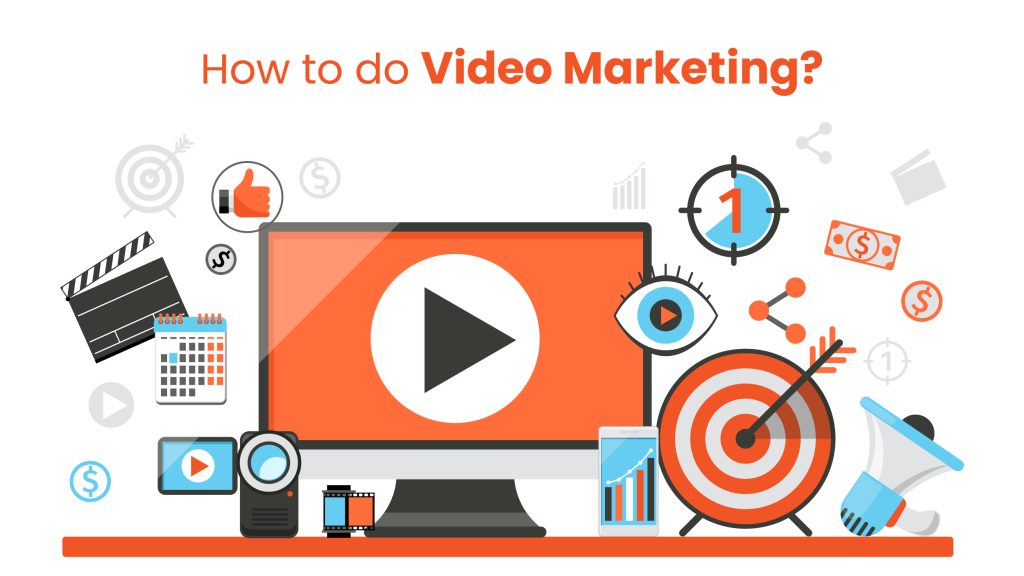Lights, camera, action! A compelling mode of communication has evolved as a marketing force in the current digital era, where consumer engagement is fiercely competitive and attention spans are short. The video has evolved into a dynamic medium that goes beyond conventional marketing bounds due to its capacity to enthrall, inspire, and leave a lasting impact. Video marketing has revolutionized how companies interact with their audience, from the social media phenomena that go viral to the heart-wrenching brand stories that make us reach for the tissues.
Let’s take a dive into the world of video marketing for business, exploring different angles such as video marketing tips, video marketing strategies, impact, and the secrets behind creating content that leaves viewers craving for more. In this exciting era, it’s lights, camera, and success, so get ready to push play on your marketing approach!
What is Video Marketing?
The practice of developing, editing, releasing, and promoting video content with the goal of promoting a company, brand, or product is known as video marketing. Businesses frequently use YouTube, Facebook, Snapchat, Vimeo, and Instagram for their video marketing campaigns.

Online, video content is rapidly taking over as the dominant medium.
According to Cisco, video made up 82% of internet traffic in 2022.
YouTube is the second most visited website on the planet, according to Alexa, and it hosts the majority of online videos.
Additionally, people do not only browse YouTube. They stay there for quite a while. As a matter of fact, 1 billion hours of YouTube videos are watched daily (YouTube).
Video Marketing Strategies
In the past, including videos in your content marketing was a common strategy.
But in order to be successful with video marketing today, you must have a sound plan in place.
Your video marketing strategy should include:
- examining the pain points of your customers
- Creating subjects that address the issues of your audience
- Creating an outline or script for your video material
- establishing a distinctive aesthetic for your brand’s films
- taking shots and editing your videos
- Utilizing video in your text-based marketing materials
- distributing your content on YouTube and other specialized video platforms
- evaluating the effectiveness of your films
- Adapting your content strategy in light of statistics and customer response
How to do Video Marketing?
Here’s what you need to do if you’re ready to start working with video.
1. Set Your Goals First
Without a stated objective in the first place, it is impossible to achieve one. Be sure to identify your goals for your video marketing project before you start anything video-specific.
Your video should typically focus on one of the following three stages of the buyer’s journey:
- Awareness: By highlighting the issues your products or services address, your film at this point serves to introduce viewers to your brand.
- Consideration: By the time your viewer reaches this stage, they are well aware of their issue and are considering a number of alternative solutions. Your video’s objective is to demonstrate how your product can benefit them and, to some extent, why it is superior to the competitors.
- Decision: You advance things in this situation. Your content must demonstrate to your customer that you have happy customers since they are almost ready to make a buy. In order to demonstrate how your product is a better option than rivals, your video may also directly contrast it with them.
 2. Identify Your Target Market
2. Identify Your Target Market
The goal of marketing videos is to sell items, not to produce an original and genre-defying work of art. They are always made with the target audience in mind.
While marketers must constantly maintain their audience at the forefront of their minds, artists can create freely and without taking their audience into account, and this independence is a crucial component of ground-breaking creative works. The best marketing videos frequently exhibit creativity and artistic talent, so this is not to imply that they can’t be done; it’s just that the process is different and creativity isn’t the final aim.
3. Select the Narrative You Want to Tell
Everyone’s development needs stories since they help us live our lives and make decisions. We seek and exchange stories almost from the minute we are born.
Of course, video is a potent form of storytelling. You must be certain of the story you want to tell if you want to make the most of it.
You’ll have a better chance of making an impact on viewers if you find a method to turn whatever is in your video into more of a narrative.
4. Keep Track of Your Creative Needs
There are many moving pieces in the making of a video. It doesn’t even begin to cover scriptwriting, casting, set design, editing, and lighting.
It’s crucial to make sure that each of these procedures is functioning well and that there is sufficient time to gather input and make modifications, if necessary. For instance, if a screenplay update is necessary, you’ll want to be sure that filming hasn’t yet begun. As a result, be sure to leave ample time between each phase in the process and check in on things occasionally, especially if there are other stakeholders involved.
5. Maintain Your Timeline
Making ensuring you have a strong timeline and are following it is important for keeping all the moving parts of a video production together.
In practice, there will probably be different timetables for every part of the video production. But it’s critical that they all proceed simultaneously without any one part delaying the others.
In order to stay on schedule and produce your video effectively, attempt to stick as closely as you can to your timeline. Your timeline will act as a broad guide for you as you work through the process and will provide you with a convenient way to keep tabs on your advancement.
Video Marketing Tips
Here are tips for producing effective video content. These pointers are intended to assist you as you prepare and produce your own video content.
Let’s jump in.
- Set objectives for a video.
- Make appropriate marketing channel selections.
- Create a budget right away.
- Don’t focus on the tools.
- Make videos based on the problems that your audience has.
- Make use of storytelling
- Before you shoot, prepare your videos.
- Make sure your videos are consistent with your brand.
- Use music to add interest.
Key Takeaways
In today’s digital economy, video marketing is a crucial form of advertising. It not only captures the audience’s attention unlike anything else, but it also keeps it.
Even though creating a video can be more time-consuming than other forms of content marketing, it should still be considered.


Comments are closed.